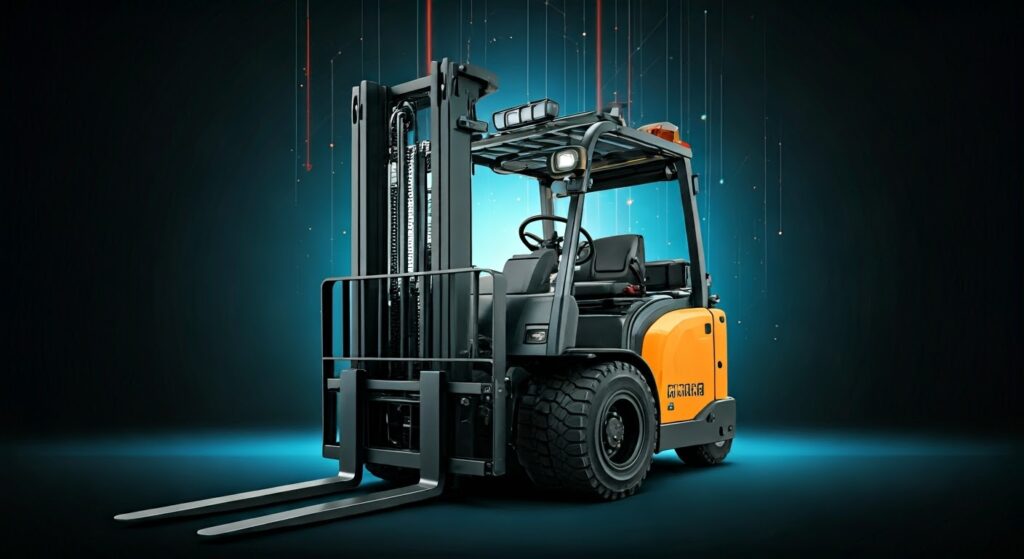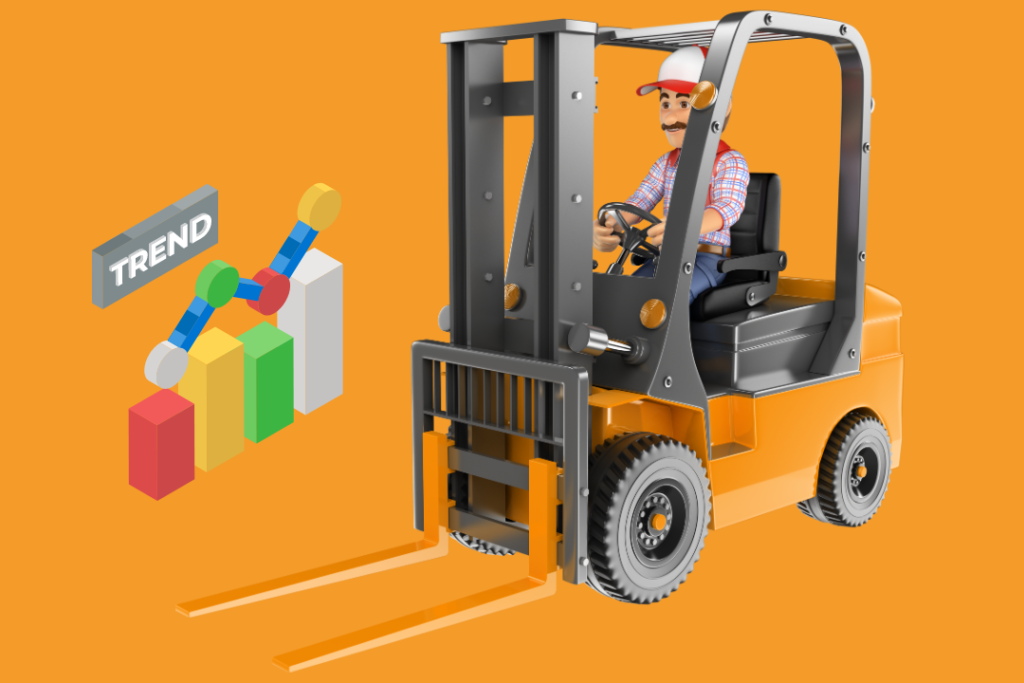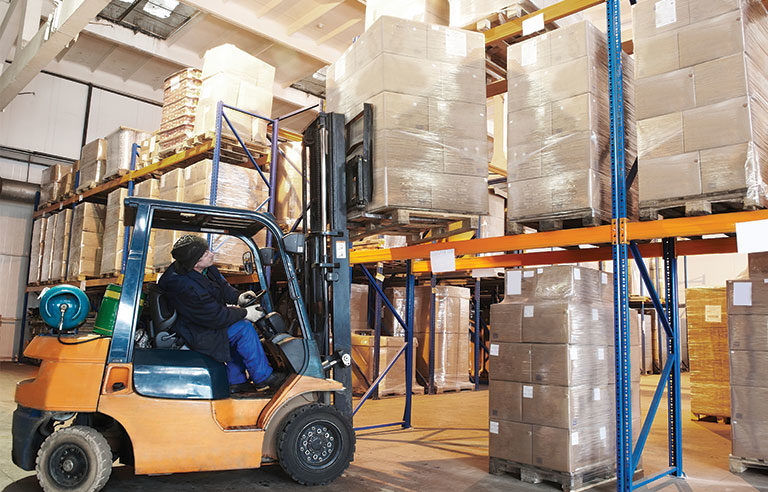Technological developments, increasing eco-friendliness, and the desire for better efficiency are the driving forces behind the big change that the forklift industry is on the brink of. The industry is going through a metamorphosis, and several trends are gradually becoming evident as we head towards 2025.
These will revolutionize the market for forklift manufacturers and operators, as well as the businesses that depend on these warehouse work animals.
Forklifts have become one of the most critical pieces of machinery in the world of logistics and others like manufacturing, retail, and construction, to name a few. We always retain our edge and efficiency in terms of providing robust, reliable, and high-performance forklift solutions. That means, first of all, that we have to be prepared early on with technology changes, and secondly, we must, at the same time, help our clients go through these changes.
Forklift Industry Trends to Watch in 2025
It is now time for the new decade’s trends to come into action in the forklift market; this is what we will cover in our next section:
The Electrification Revolution Continues:
Therefore, as we try to suppress the trend we would be fooling ourselves to think that the electrification of the forklifts is a fad when the fact is that it is just the beginning of the required transformation that is taking place there. Although there have been some environmental and operational drivers behind this trend, this change that is expected to take place in the forklift manufacturing industry in 2025 is more than real, and electric models are becoming the preference for the majority of indoor and also outdoor applications.
Lithium-Ion Batteries Took Over: The technological progression of battery accelerator particularly the great number of lithium batteries available has drastically changed the game. These are the kind of batteries that offer quick filling processes, keep operating for even longer, and have a longer life cycle in opposition to the traditional lead-acid batteries. The electric forklifts are not dependent on the time for recharging the batteries and they are even more productive. An all-electric world is no longer a far-fetched dream with lithium-ion batteries being the most prevalent energy-storage solution.
No Emissions and Noiseless Operations: Electric forklifts are responsible for zero harm emissions which makes them perfect for indoor conditions requiring clean air. The noiseless operation is another factor contributing to a better, healthier and safer working environment of staff and drivers.
Automation and Robotics: The Rise of the Autonomous
Workforce: The forklift industry is experiencing a quick shift from manual to autonomous; the change that otherwise would be far-off in the future is occurring now, happening very swiftly. People in charge of the warehouses and distribution centers are now looking into the use of Automated Mobile Robots (AMR) and automatic forklifts to facilitate their operations by reducing of labor costs, and in the case of the forklifts, minimizing or completely doing away with human errors.
It Is Expected That There Will Be An Expansion Of Both Types Of Fleets: It is impossible not to think about the fact that payback is right around the corner when the machines begin to carry out all the dull processes, and the employees are free to run the processes which are of further replication of the ordinary type. This is the best way to ensure that the production flow is far much better. According to the hybrid fleets, the forklifts do repetitive tasks while the people carry out the rest of the activities. As the result is that the business owner will have people engaged only in those critical areas of the business.
Leading The Way In Terms Of Navigation And AI:
When Imaging’s intelligent powered forklift trucks use sensors and cameras to detect and analyze unseen barriers while the AI programming helps to plan and direct the movement of the truck. It uses real-time data and incrementally learns as well with the result that continual optimization of the route is achieved and energy is saved.
For instance, if the truck is in the middle of its journey and there is a sudden change of environment, it can gauge the speed of adaptation based on new data. Then it can assess the situation and Read More use it to decide whether the new routes Snowplow will be more effective.
Utilization of Telematics and IoT in Fleet Management through Data-Driven Approaches:
The underlying concept of the Internet of Things that has caused the revolution in Material handling equipment (MHEs) is the same that converts the forklifts into “data centers on wheels.” Telematics systems attached to new forklifts allow companies to check the surroundings of their fleet as well as maintain it remotely.
- Real-time Insights: Managers can opt for a variety of operational data through a web-based platform that are connected to their facilities. The information consists of, but is not limited to, productivity rate, forklift operators’ performance, and critical maintenance requirements. Based on this, the business will be in a better position to decide, do fleet management, and streamline operations.
- Predictive Maintenance: Data analysis and applied data science can forecast an imminent repair need and, therefore, enable the early diagnosis and treatment of a fault before the appearance of signs, saving a company from the hassle of unplanned restoration and money. These technologies have the secondary benefits of guaranteeing the sustainability and high computing speeds for the device.
New-for-Safety Additions: Reframing the Current Importance of the Operator:
The development of the forklift safety system as the most significant factor in the new technology-enabled forklifts is directly proportional to the intellectual strides in forklifts.
- Advanced Collision Prevention: Devices like automatic speed, loading stability monitoring, proximity sensors, and zonal recognition systems have become part of the normal technology items within the industry. These machines can identify potential hazards and modify the working of a forklift to avoid the occurrence of incidents.
- Improved Ergonomics and Operator Comfort: In the fight against fatigue, efficiency is the key benefit caused by the direct link between operator disorders and productivity. To achieve this, the new trucks have been created with ergonomic designs that are much improved from the preceding.
Reaching this stage is a result of the design that includes seats which are adjustable, clarity of vision, calming down of the noise, and friendlier controls, among others. The net effect contributes towards a more compliant and secure workspace besides facilitating occupational health.
Sustainability Beyond Electrification:
Despite the fact that electric forklifts signify a significant move in sustainability, the industry needs to walk the green path for an even longer stretch.
- Eco-conscious Manufacturing: The tendency of manufacturers is to more and more concentrate on the inclusion of recycled materials in order to design suitable products and on the one hand to take-up all available energy-efficient modes of production on the other
- Battery Recycling Initiatives: Both lead-acid and lithium-ion are vital types involved in the recycling of robust recycling programs for batteries that are a part of creating a circular economy and decreasing landfill waste.
American Forklifts: Your Partner in the Future of Material Handling
At American Forklifts, our mission is to provide our customers with the latest, most high-performance forklift solutions. We stay ahead of the game and lend our support to those who adhere to these industry trends to enable them to achieve levels or efficiency that otherwise would not be possible, bring in the safety factor, and promote the environmentally friendly journey of the globe.
Our commitment does not stop at the mere selling of the equipment we also extend services in the categories of rental, maintenance, training, spare parts, consulting, [mention specific services offered on americanforklifts.org if available, e.g., rental, maintenance, training, parts, consulting]. Through us, material handling will become an easy task through our services and hence, the right equipment for your unique needs will be found.
Looking Ahead:
The lift trucks industry in 2025 is nothing short of dynamic and thrilling. An equally exhilarating part of the sector is the mix of the latest state-of-the-art technology, the strong retention of the sustainability initiatives, and a firm guaranteeing of safety, all of which are peeling off the traditional barriers to materials handling.
They may simply be complex to the business; however, by being proactive and making use of the expertise of experts similar to American Forklifts, companies can expect a double increase in productivity and job excellence resulting in operational success.
Read the latest FAQs visiting the world of fork-lifts in 2025 in a nutshell:
Q: Are electric forklifts the real future?
A: Yes, forklifts that are electric, especially the ones powered by lithium-ion batteries, are quickly becoming the industry standard due to the zero-emission factor, lower cost of operation, and faster charging.
Q: Can autonomous forklifts do the work of human drivers?
A: Not completely. You can expect to see more “hybrid” fleets in the future that work with autonomous forklifts on their repetitive operations, thus improving the employability while human workforces concentrate on complex tasks.
Q: What is telematics and why is it significant for forklifts?
A: Telematics via IoT is to gather real-time information on your forklifts usage, maintenance, and operator behavior that can be used to do such things as: reduce the downtime, battery recharging, and product safety with wear-and-tear analysis from the data-gathered insights.
Q: How does the industry use the new technologies to focus on safety?
A: Smart safety features like collision prevention, automatic speed control, load stability monitoring, as well as ergonomic improvements are all in use to make sure that the drivers are safe and the accidents are avoided.
Q: Except for electric/using batteries, what are the other green ways that the world of forklifts adopts?
A: The green program consists of the sustainable production (recycled materials, production that does not consume a lot of energy) and the introduction of recycling processes for batteries thus reducing the negative environmental impact of unnecessary disposal.
Q: Are lithium-ion battery-operated forklifts more beneficial than lead-acid ones?
A: In most areas, it is an established fact that Li-ion beats lead-acid in several aspects such as shorter charging time, longer lifespan, consistency in performance without maintenance tasks and the fact of them being nearly 99% recyclable easily outperforms the traditional lead-acid batteries in virtually all areas.
Q: What are the primary perks of autonomous forklifts?
A: Productivity, upped safety (no human mistakes), lower labor costs (less dependence on labor), and logistics/flexibility for warehouse operations.



